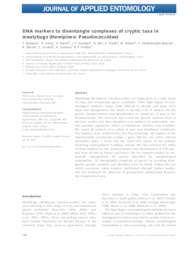DNA markers to disentangle complexes of cryptic taxa in mealybugs (Hemiptera: Pseudococcidae).
DNA markers to disentangle complexes of cryptic taxa in mealybugs (Hemiptera: Pseudococcidae).
Autoria: MALAUSA, T.; FENNIS, A.; WAROT, S.; GERMAIN, J.-F.; RIS, N.; PRADO, E.; BOTTON, M.; VANLERBERGHE-MASUTTI, F.; SFORZA, R.; CRUAUD, C.; COULOUX, A.; KREITER, P.
Resumo: Mealybugs (Hemiptera: Pseudococcidae) are major pests of a wide range of crops and ornamental plants worldwide. Their high degree of morphological similarity makes them difficult to identify and limits their study and management. We aimed to identify a set of markers for the genetic characterization and identification of complexes of taxa in the Pseudococcidae. We surveyed and tested the genetic markers used in previous studies and then identified new markers for particularly relevant genomic regions for which no satisfactory markers were available. We tested all markers on a subset of four taxa distributed worldwide. Five markers were retained after this first screening: two regions of the mitochondrial cytochrome oxidase I gene, 28S-D2, the entire internal transcriber space 2 locus and the rpS15-16S region of the primary mealybug endosymbiont Tremblaya princeps. We then assessed the utility of these markers for the characterization and identification of 239 samples from 43 sites in France and Brazil. The five markers studied (i) successfully distinguished all species identified by morphological examination, (ii) disentangled complexes of species by revealing intraspecific genetic variation and identified a set of closely related taxa for which taxonomic status requires clarification through further studies, and (iii) facilitated the inference of phylogenetic relationships between the characterized taxa.
Ano de publicação: 2011
Tipo de publicação: Artigo de periódico
Unidade: Embrapa Uva e Vinho
Palavras-chave: Caracterização molecular, Cochonilha, DNA, Entomologia, Genética, Identificação genética, Inseto, Marcador Molecular
Observações
1 - Por padrão são exibidas publicações dos últimos 20 anos. Para encontrar publicações mais antigas, configure o filtro ano de publicação, colocando o ano a partir do qual você deseja encontrar publicações. O filtro está na coluna da esquerda na busca acima.
2 - Para ler algumas publicações da Embrapa (apenas as que estão em formato ePub), é necessário ter, no celular ou computador, um desses softwares gratuitos. Sistemas Android: Google Play Livros; IOS: iBooks; Windows e Linux: software Calibre.
Acesse outras publicações
Acesse a Base de Dados da Pesquisa Agropecuária (BDPA) para consultar o acervo completo das bibliotecas da Embrapa.

